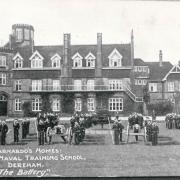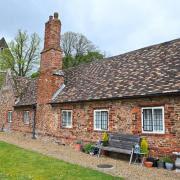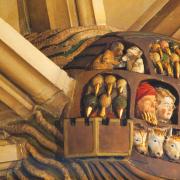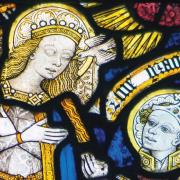On the evening of Thursday September 10, 1874, the so-called 'express' from London, due into Norwich Thorpe Station at 9pm, was running late again. Among the travellers, Norwich draper and outfitter George Womack, waited anxiously for his return journey to Great Yarmouth, following a difficult day at his shop on the corner of Dove Street and Lobster Lane. Atrocious wet weather had deterred passing trade and he’d been distracted by nervous anticipation. Tonight, he must initiate a difficult but necessary 'conversation' with his mistress. Their secret relationship was over. He missed his two young daughters and his wife Emma. It was time to return to his comfortable city home.
While pacing the platform, George Womack encountered a friend, Mr Banks, and was introduced to a Miss Chapman, who she was escorting Banks’ 12-year-old daughter to Great Yarmouth. Ever the gallant, George offered to travel with the pair. Once on board, Miss Chapman requested that George switch seats, so that the child could watch from the window. It would be his pleasure.

Meanwhile, at Brundall Station, the mail train from Great Yarmouth, as it did every night, sat in a siding. It was timetabled that the express from London pass first, so allowing the mail train to access the single line into the city.
At around 9.20 pm, the express finally arrived in Norwich. In the clamour to turn it around swiftly, a momentary misunderstanding between the tetchy night inspector Alfred Cooper, and headstrong young telegraph clerk John Robson, meant that both trains were despatched onto the same single line, unwittingly careering towards an inevitable head-on collision.
At 9.30 pm, the residents of the picturesque riverside village of Thorpe-Next-Norwich, were stunned by a ‘deafening peal of thunder’. Carriages were plunged into total darkness as some, including Miss Chapman and Miss Banks, were catapulted onto the marshes below. Miraculously the pair were unhurt and stumbled to a near-by house. Seventeen travellers were killed where they sat, crushed or mangled by falling ironwork and disintegrating carriages.
An evocative eye-witness account of the event was published in the Norwich Mercury on 16th September.
'The noise of the crushing carriages, the roaring of the steam, and the shrieks and cries of the injured and uninjured, heard amid the thunder and lightning, were beyond belief. Gentlemen and inhabitants ran to the spot, while rain poured down in torrents, loud peals of thunder rolled around, with repeated flashes of lightning, all adding to the awful nature of calamity.'
Among the wreckage lay the broken unconscious figure of George Womack. Around him, the dead were respectfully carried into the skittle-alley in the nearby Three Tuns Pub (Rushcutters Arms today) to await identification.
At Norwich Station, Cooper and Robson realised the enormity of the situation. With no way of stopping the trains, cab drivers were sent to summon surgeons and physicians from the Newmarket Road Hospital, and from their grand homes in Upper St Giles Street. Dismayed doctors made their way to the station, clutching bandages, amputation saws and bottles of brandy. A maintenance train took them over Thorpe Island, in search of the crash scene. The badly injured, including George, were transported into the city either on special trains, or by horse-drawn vehicles, passing the pathetic line of walking wounded along the Yarmouth Road. George was laid in the waiting room of Norwich station, rescuers fearing any immediate onward journey to hospital might kill him. Local women watched over him, until at dawn he finally succumbed to his wounds.
Every class of Victorian society was travelling that night; gentlemen landowners, former soldiers, clergymen, doctors, saddlers, businessmen, seamstresses, domestic servants, fishmongers and a beautiful 18-year-old heiress. On the following morning, the Eastern Daily Press printed the basic facts. So began a frenzy of daily national and international reportage, lasting well into the summer of 1875, including lurid eyewitness accounts, funerals, increasing death toll, legal procedures, medical bulletins and opinion pieces.
George Womack was interred inside the Womack family vault in Rosary Cemetery on Tuesday September 15. This was the first non-denominational cemetery in the county, opened in June 1821, soon becoming a fashionable final resting place for the prestigious families of Norfolk, including Colman, Boardman and Gurney. On that same day, horse-drawn glass carriages drove into the Rosary. Funded by Great Eastern Railway, driver John Prior and fireman James Light were buried together, John’s headstone set deliberately higher than that of James, denoting their relative status.

Following the inquests, the London Board of Trade inquiry concluded that there was a manslaughter case to answer. Both Cooper and Robson were charged and bailed, pending their trial in the Shire Hall during the following April. The disaster was described as:
'… the most serious collision between trains meeting one another on a single line of rails […] that has yet been experienced in this country.’
Family members of the deceased and those now incapable of working, rushed to consult lawyers, seeking compensation from Great Eastern Railway. One hundred and seven claims were lodged, some settled quickly by the law firms. But many were contested and in February 1875, the cases began, each recorded verbatim in the press. Great Eastern had already admitted liability, it was now for its lawyers to keep the pay-outs as low as possible. In almost all the cases, they did a good job. On April 12, following a failed attempt to settle out of court, the case of Womack v. The Great Eastern Railway Company began. Emma was obliged to face a courtroom of lawyers, reporters and inquisitive onlookers. Emma explained how in January 1874 the couple separated, George allowing Emma only £300 a year to live on (£28,000). The QC for Great Eastern was quick to interject:
‘He went to live at Yarmouth with someone else’.
Emma continued:
‘My husband sent me a letter the day but one before the accident. He pressed me to return to him, but no arrangement was then come to’.
The lawyers vehemently argued over the true value of George’s business. Had there been any financial impropriety? Might he have been secretly bankrupt when he died? Having heard all the evidence, the judge summed up, offering the killer blow.
‘It is evident that Mr Womack’s business was a large and flourishing one, seeing that out of it he was able to allow his wife and children £300 a year and keep up a second establishment with a mistress and perhaps other children there.’
Emma was mortified. The jury returned verdict for the plaintiff, awarding the disappointing sum of £3,000 (£284,000 today). Four years later, Emma married her cousin, Charles Arthur Middleton, taking George’s children to Australia in search of a happier life. Great Eastern eventually paid out the equivalent of four million pounds, a record for railway companies at that time.
And what of Cooper and Robson? The two men had stood together in the dock at Shire Hall, offering conflicting stories. After much deliberation, the jury found the older man, Cooper, to be guilty of manslaughter, sentencing him to eight months hard labour in Norwich Castle Prison. Robson was found not guilty, walking free and disappearing from any future records. His sentence over, Cooper took his family up to York, opening a fishmonger’s business.
For some time, engineer and designer Edward Tyer, had been working on a new signalling device for use on single-track rails. As a direct result of the Thorpe Disaster, Tyer was instructed by the government to hasten its completion. Finally, in March 1878, the Tyer Tablet System was patented, potentially saving many lives. But, tragically for George Womack and the 25 other victims of The Great Thorpe Railway Disaster, it was just far too late.
Phyllida Scrivens lives in Thorpe St Andrew, near Norwich, with her husband Victor. In 2014 she graduated with an MA in non-fiction creative writing with biography, from the University of East Anglia. This led to the publication of her first book, Escaping Hitler, the biography of Norwich legend Joe Stirling, followed by the award-winning Lady Lord Mayors of Norwich, and, in 2021, The Great Thorpe Railway Disaster 1874, all published by Pen and Sword Books.

The residents of Thorpe St Andrew are arranging a series of commemorative events in September and October
Friday September 13, at 7.30pm at St Andrew’s Centre, off Thunder Lane. A talk on the disaster by Phyllida Scrivens, author of The Great Thorpe Railway Disaster.
Saturday September 14. Two guided walks hosted by Thorpe History Group. For details of how to book a space go to thorpe-history-group.org/talks-walks/.
Sunday September 15 at 10.30am. The dedication by The Bishop of Norwich of a commissioned bronze plaque, bearing the names of the 26 victims. This will take place at the 10.30am service in the Parish Church on River Green.
October 10-12 will see performances of a new play, Crossed Lines, by Thorpe Players at Roxley Hall, Thorpe St Andrew. More details from thorpe-players.co.uk/whats-on.html
Further information is available from Phyllida Scrivens by emailing phyllida.scrivens@icloud.com.



























